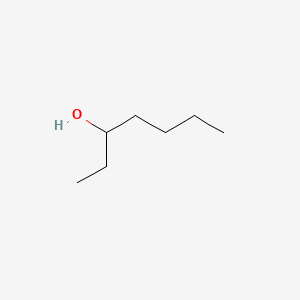
|
3-heptanol |
3-heptanol is a lipid of Fatty Acyls (FA) class. |
11 |
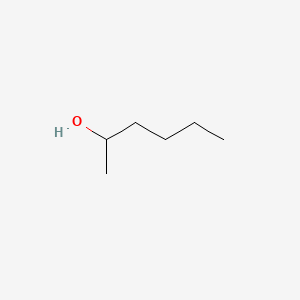
|
2-hexanol |
2-hexanol is a lipid of Fatty Acyls (FA) class. 2-hexanol often locates in Clone. The associated genes with 2-hexanol are PDC gene. The related lipids are 2-hexanol and 1-Octanol. |
88 |

|
Gamma-valerolactone |
Gamma-valerolactone is a lipid of Fatty Acyls (FA) class. |
122 |
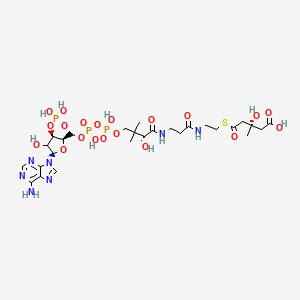
|
HMG-CoA |
Hmg-coa is a lipid of Fatty Acyls (FA) class. Hmg-coa is associated with abnormalities such as Cardiovascular Diseases, Hypercholesterolemia, Metabolic Diseases, Hyperhomocysteinemia and Morphologically altered structure. The involved functions are known as ketone body biosynthetic process, Regulation, Mutation, enzyme activity and HMG-CoA synthase activity. Hmg-coa often locates in Mitochondria, Cytoplasmic matrix, Hepatic, Membrane and Flank (surface region). The associated genes with HMG-CoA are Human gene, HMGCS2 gene, PPARA gene, ACSL1 Gene and Candidate Disease Gene. The related lipids are Fatty Acids, Sterols, Dehydrocholesterols, Lipopolysaccharides and 7-dehydrocholesterol. |
355 |
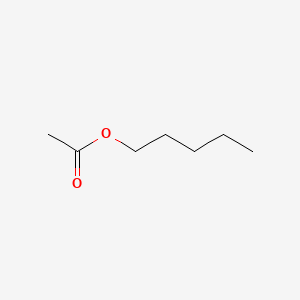
|
Amyl acetate |
Amyl acetate is a lipid of Fatty Acyls (FA) class. |
399 |
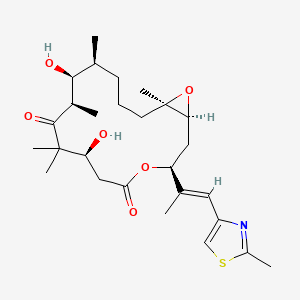
|
Epothilone B |
Epothilone B is a lipid of Polyketides (PK) class. Epothilone b is associated with abnormalities such as Myelosuppression, Measurable Disease, Neuropathy, Neutropenia and Thrombocytopenia. The involved functions are known as Cell Cycle Arrest, Apoptosis, Signal Transduction, Cytokinesis and Caspase Activation. Epothilone b often locates in Mitochondria, Cytoplasmic matrix, Microtubules, Spindle and Protoplasm. The associated genes with Epothilone B are TNFSF10 gene, DIABLO gene, FADD gene, BCL2 gene and BCL2L1 gene. The related lipids are Promega and Phosphatidylserines. The related experimental models are Xenograft Model and Mouse Model. |
492 |
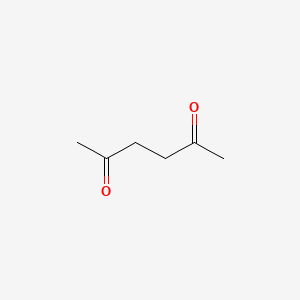
|
2,5-hexanedione |
2,5-hexanedione is a lipid of Fatty Acyls (FA) class. |
646 |
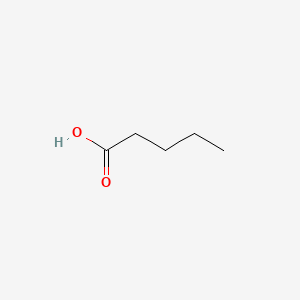
|
Valeric acid |
Valeric acid is a lipid of Fatty Acyls (FA) class. Valeric acid is associated with abnormalities such as Papillon-Lefevre Disease, Obesity, Diabetes Mellitus, Non-Insulin-Dependent and Dehydration. The involved functions are known as Process, Odorant, Stimulus, Irritation and Phenomenon. Valeric acid often locates in Receptive field, soluble, Extracellular, Entire gastrointestinal tract and Body tissue. The associated genes with Valeric acid are Orthologous Gene, Fusion Gene and AS gene. The related lipids are Valerates, butyrate, Propionate, Caproates and Palmitates. |
838 |
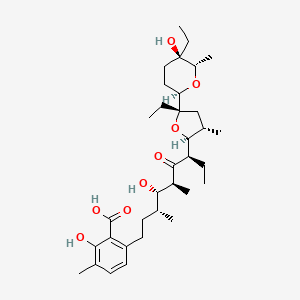
|
lasalocid |
Lasalocid a is a lipid of Polyketides (PK) class. |
1136 |
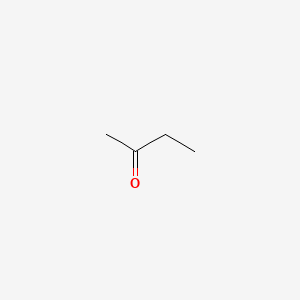
|
2-butanone |
2-butanone is a lipid of Fatty Acyls (FA) class. |
1159 |
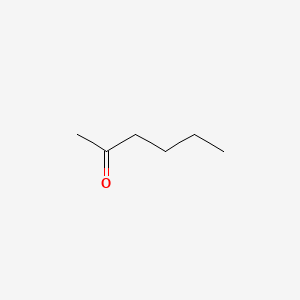
|
2-hexanone |
2-hexanone is a lipid of Fatty Acyls (FA) class. 2-hexanone is associated with abnormalities such as Virus Diseases, Egg drop syndrome, Senile Plaques, Chronic Obstructive Airway Disease and COPD exacerbation. The involved functions are known as Permissiveness, Biological Function, Synthesis, Tropism, Amplification and Cellular Tropism. 2-hexanone often locates in Vertex, viral capsid, Tissue fiber, Cell surface and host. The associated genes with 2-hexanone are Polylysine, Fusion Protein, Genome, Lac Gene and chimeric gene. The related lipids are Promega, Lipopolysaccharides, oligofectamine, Propionate and FuGene. The related experimental models are Transgenic Model, Xenograft Model and Rodent Model. |
1204 |

|
Heptane |
Heptane is a lipid of Fatty Acyls (FA) class. The involved functions are known as cell activation and Synthesis. Heptane often locates in immunological synapse. |
1600 |

|
(e,e,e,e)-squalene |
(e,e,e,e)-squalene is a lipid of Fatty Acyls (FA) class. (e,e,e,e)-squalene is associated with abnormalities such as Hypercholesterolemia and Cataract. The involved functions are known as Process, metaplastic cell transformation, Protein Overexpression, Anabolism and Biosynthetic Pathways. (e,e,e,e)-squalene often locates in Membrane, Protoplasm, Plasma membrane, Tissue membrane and Back. The associated genes with (e,e,e,e)-squalene are Genome, IMPACT gene, GAPDH gene, GTF2I gene and Chromatin. The related lipids are Membrane Lipids, cycloartenol, Sterols, Fatty Acids and Nonesterified Fatty Acids. |
1766 |
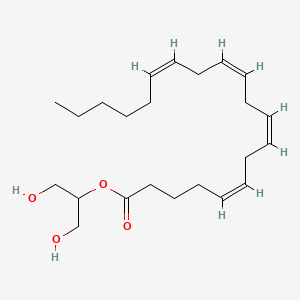
|
2-arachidonoylglycerol |
2-arachidonoylglycerol is a lipid of Glycerolipids (GL) class. 2-arachidonoylglycerol is associated with abnormalities such as Atherosclerosis, Heart Diseases, Inflammatory disorder, Colitis and Peripheral Neuropathy. The involved functions are known as Immunoreactivity, inhibitors, Stimulus, Esthesia and Signal Transduction. 2-arachidonoylglycerol often locates in Back, Presynaptic Terminals, Brain region, Blood and Body tissue. The associated genes with 2-arachidonoylglycerol are ADRBK1 gene, Homologous Gene, MGLL gene, PLA2G4A gene and peptide V. The related lipids are oleoylethanolamide, Lipopolysaccharides, Promega, stearic acid and 1-stearoyl-2-arachidonoylglycerol. The related experimental models are Knock-out. |
1892 |
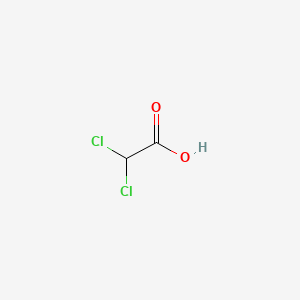
|
Dichloroacetic acid |
Dichloroacetic acid is a lipid of Fatty Acyls (FA) class. Dichloroacetic acid is associated with abnormalities such as Acidosis, Lactic, Metabolic Diseases, CLEFT LIP, CONGENITAL HEALED, Asthma and hyperthyroid. The involved functions are known as inhibitors, Chlorination, Metabolic Inhibition, Process and Sterility. Dichloroacetic acid often locates in Intestine - Large Intestine - Cecum (MMHCC), Mouse Liver, Back and Head. The associated genes with Dichloroacetic acid are GSTZ1 gene, PSMA5 gene and Maleylacetoacetate isomerase. The related lipids are Nonesterified Fatty Acids. |
2361 |

|
1-Oleoyl Lysophosphatidic Acid |
1-Oleoyl Lysophosphatidic Acid is a lipid of Glycerophospholipids (GP) class. 1-oleoyl lysophosphatidic acid is associated with abnormalities such as Myocardial Infarction, early pregnancy, Scleroderma, Blind Vision and Hyperlipidemia. The involved functions are known as Agent, Blood coagulation, Selection, Genetic, Analyte and Biological Processes. 1-oleoyl lysophosphatidic acid often locates in Tissue specimen, Body tissue, Blood, Membrane and Skin. The associated genes with 1-Oleoyl Lysophosphatidic Acid are Mucin-16, Peptides, SMAD4 gene, RND1 gene and Polypeptides. The related lipids are lysophosphatidic acid, A(2)C, Lysophospholipids, Fatty Acids and sphingosine 1-phosphate. The related experimental models are Mouse Model, Knock-out, Cancer Model, Xenograft Model and Arthritis, Adjuvant-Induced. |
3463 |
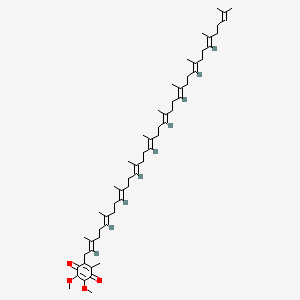
|
Coenzyme Q10 |
Coenzyme q10 is a lipid of Prenol Lipids (PR) class. Coenzyme q10 is associated with abnormalities such as Nephrotic Syndrome, Diabetes, COENZYME Q10 DEFICIENCY, Deafness and Hypertensive disease. The involved functions are known as Mutation, Process, Oxidation, Electron Transport and Oxidants. Coenzyme q10 often locates in Mitochondria, soluble, Plasma membrane, Body tissue and Inner mitochondrial membrane. The associated genes with Coenzyme Q10 are MT-CYB gene, ATP5B gene, cytochrome c'', STN gene and NPC1 gene. The related lipids are Total cholesterol and Lipid Peroxides. The related experimental models are Mouse Model. |
4537 |

|
Anandamide |
Anandamide is a lipid of Fatty Acyls (FA) class. Anandamide is associated with abnormalities such as Dehydration. The involved functions are known as Process, Phenomenon, Phosphorylation, Catabolic Process and Gene Expression. Anandamide often locates in Nuchal region, Microglial and Hepatic. The associated genes with Anandamide are SGPL1 gene, SPTLC1 gene, RPSA gene, KDSR gene and SMPD1 gene. The related lipids are Sphingolipids, Lipopolysaccharides, Lysophospholipids, LYSO-PC and lysophosphatidylethanolamine. |
4747 |

|
quercetin |
quercetin is a lipid of Polyketides (PK) class. Quercetin is associated with abnormalities such as Coronary heart disease, Myocardial Infarction, Cirrhosis, Coronary Arteriosclerosis and Vascular ring. The involved functions are known as Vasodilation, physiological aspects, Fermentation, Process and Ingredient. Quercetin often locates in Arterial system, Endothelium, Skin, Endothelium, Vascular and Tissue specimen. The associated genes with quercetin are P4HTM gene, SULT gene, UGT1A1 gene, ARHGAP26 gene and PLXNB1 gene. The related lipids are blood lipid, Promega, Steroids, Phosphatidylserines and Fatty Acids. The related experimental models are Knock-out, Mouse Model, Xenograft Model, Tissue Model and Cancer Model. |
5377 |
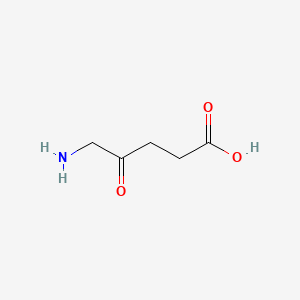
|
5-aminolevulinic acid |
5-aminolevulinic acid is a lipid of Fatty Acyls (FA) class. |
5869 |



















